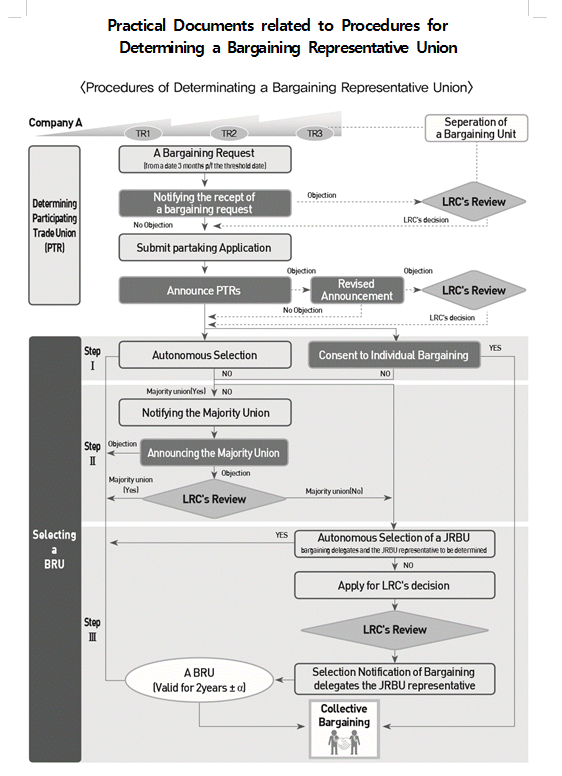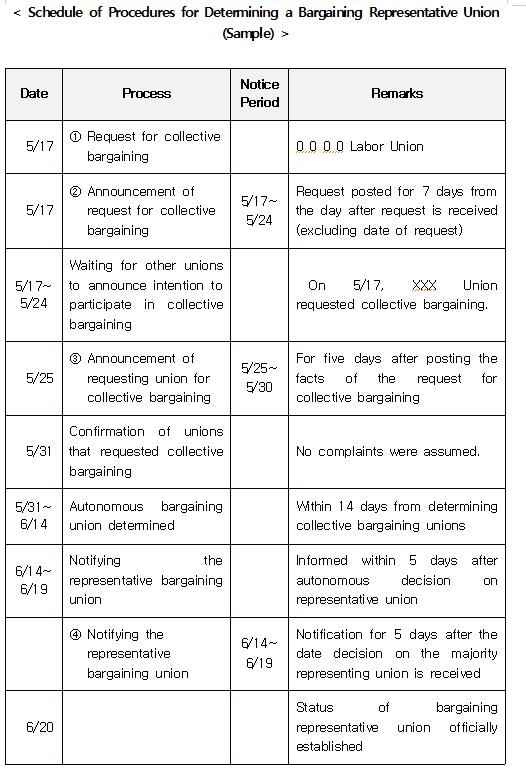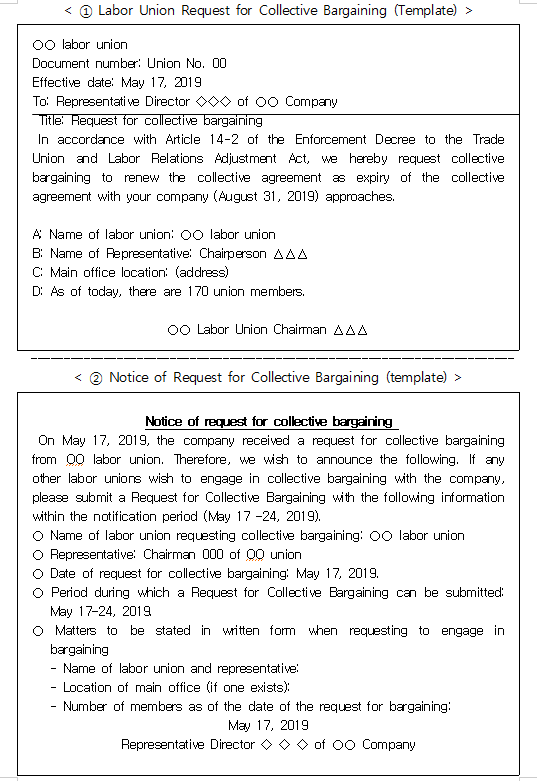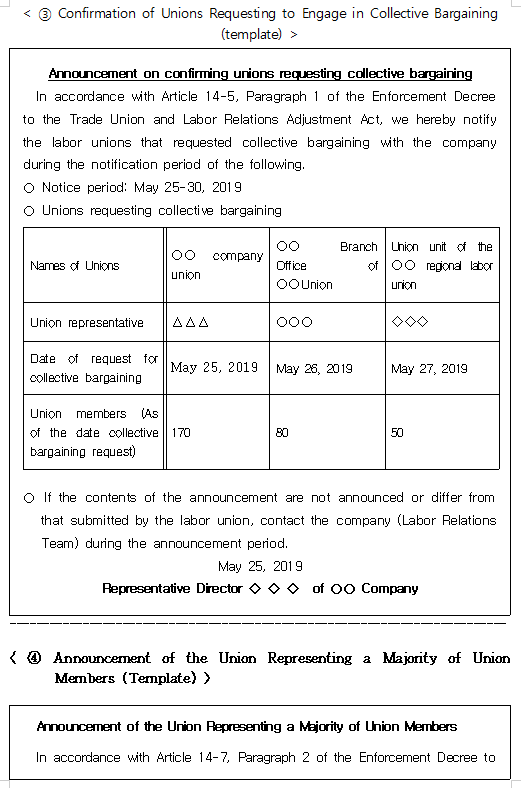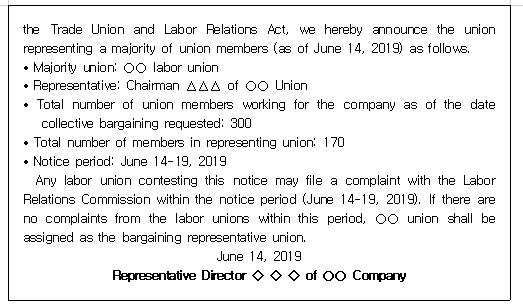Chapter 3. Collective Bargaining and Collective Agreements
- 2. Multiple Labor Unions and Determining the Representative Union Channel for Bargaining
-
1. Understanding the Multiple Union System This article is based on the Ministry of Employment and Labor Guide, "Manual on multiple labor unions in a business (workplace)" (December 2010).
(1) Concept
Effective July 1, 2011, employees are free to organize two or more labor unions in the unit of a business (or workplace) or to join such labor union(s), according to revision of the Trade Union and Labor Relations Adjustment Act (hereinafter referred to as ‘the Trade Union Act’). However, this revised law stipulates the application of one unified collective agreement in a business (or workplace) by introducing a single bargaining channel. This is designed to prevent disturbances from duplicate bargaining, different applications of working conditions, and serious disputes between unions.
Generally in the Multiple Union System, only the largest labor union representing more than half of a company’s union members will engage in collective bargaining and collective contracting as the bargaining representative union, and has the duty to represent the minority labor unions fairly. Since this Multiple Union System was implemented on July 1, 2011, many changes have occurred in labor relations between employers and the labor unions, both positive and negative. The positive changes include guaranteeing the right to multiple labor unions in one company where employees are free to join the one they like, and even establish their own. The negative changes include the weakening of industrial unions as they are now splintered and must choose a bargaining representative union to represent all of them in each workplace or business unit. Some companies have taken advantage of this change by subsidizing or otherwise supporting company-friendly labor unions to the point where they obtain the majority of union membership. In such situations, the existing combative and unfriendly labor unions find themselves generally powerless as they become minority labor unions that have lost their right to bargain and take action collectively.
(2) Determining the representative bargaining union and bargaining methods
1) Principle
In cases where a company-level labor union was determined and confirmed as the representative bargaining union through the procedures mentioned above, it can conclude a collective agreement by negotiating with the employer. A branch or unit of an umbrella labor union (such as an industrial union) at the business or workplace shall also participate in determining and confirming the representative bargaining union through the procedures mentioned above. Accordingly, if the branch or unit of the umbrella union or the company-level labor union did not participate in determining and confirming the representative bargaining union, it cannot negotiate with the employer. In such a case, if the employer rejects a request for negotiation with the umbrella union, it will not be considered unfair labor practice.
2) Determining the representative bargaining union case-by-case
ⓐ In cases where there are two company-level labor unions
Labor Union A (300 persons)
Labor Union B (200 persons)
Above all, Labor Union A and Labor Union B shall autonomously determine the representative bargaining union. If they fail to do so, Labor Union A becomes the representative bargaining union as it has the majority of union members.
ⓑ In cases where there are labor unions at the company, local, and industry level
Labor Union A (500 persons)
Local Union Branch (50 persons)
Industrial Union (200 persons)
Above all, company-level Labor Union A, local-level Labor Union B and Industrial Union C shall autonomously determine the representative bargaining union. If the labor unions fail to do so, Labor Union A becomes the representative bargaining union as it has the majority of the total 750 union members.
ⓒ In cases where there are two industrial unions and one company labor union
Industrial Union B (500 persons)
Labor Union A (300persons)
Labor Union C (250 persons)
Above all, the three labor unions shall autonomously determine the representative bargaining union. If they fail to do so, none of the labor unions represent a majority of the 1,050 members, but if a particular labor union comes to represent a majority of the members by coalition or commission, that joint union becomes the representative bargaining union as it will now represent a majority of the membership.
3) Exception for the representative bargaining union system: division of bargaining unit
The bargaining unit shall be a business or workplace, but if it is deemed necessary to divide the bargaining unit given the considerable disparity in working conditions, employment status, bargaining practices, etc., in a business or workplace, the Labor Commission may decide to divide the bargaining unit at the request of either or both of the parties to the labor relationship.
2. Determining the Representative Union Channel for Bargaining
(1) Summary
In order to start bargaining procedures with the employer in a business or workplace, all labor unions shall participate in the procedures for determining the bargaining channel and determine the representative bargaining union. The regulation to establish a bargaining channel is mandatory for both the labor union and the company. Regardless of type of organization or if they duplicate each other, all labor unions which employees of a business or workplace have joined or organized shall participate in the procedures to determine the representative union to be the bargaining channel. Determining the bargaining channel is 1) to confirm which labor unions are participating in the bargaining channel and 2) to determine a single representative bargaining union.
(2) Procedures confirming participating labor unions
1) Demand for bargaining (by the labor union)
A labor union may begin to request bargaining with the employer three months before the expiration date of the collective agreement, and in this case, the request shall be made in writing, including the name of the labor union and the number of union members as of the date of the request for bargaining.
2) Public notice of the labor union’s request for bargaining (by the employer)
Upon receiving a request to bargain from a labor union, an employer shall put a notice on a bulletin board in the business or workplace concerned for seven days from the date of receiving said request. Even should there be only one labor union in that business or workplace, the employer shall post notice of the labor union’s request for bargaining as there may be employees who have joined other industrial or local labor unions.
3) Application by another labor union for bargaining (by the labor union)
If another labor union wants to participate in the collective bargaining, it shall request to do so within the seven-day notice period. Unions that fail to do this will be unable to participate in the procedures to determine a bargaining channel.
4) Confirmation of labor union request for bargaining (by the employer)
The employer shall give public notice of the submitted request for five days beyond the seven-day notice period. Only labor unions that were confirmed as labor unions requesting bargaining can participate in the procedures to determine the representative bargaining union and apply for redress of any violation of the right for fair representation.
(3) Procedures for determining the representative bargaining union
1) Summary: If there is only one labor union confirmed and determined as a labor union requesting bargaining, that labor union shall be the representative bargaining union. If two or more labor unions are confirmed and determined as labor unions requesting bargaining, the labor unions shall determine one representative bargaining union regardless of the type of organization or duplication in organizational coverage and negotiate with the employer. An exception is possible if separate bargaining with the other labor union(s) is accepted by the employer.
2) Autonomous determination (by the labor union)
The labor unions, after confirmed or determined as labor unions requesting bargaining, can autonomously determine the representative bargaining union within 14 days after such confirmation. As there are no special procedures on or limits to the method used to determine the representative union, the only requirement is that the labor unions collectively agree.
3) Confirmation of a majority labor union (by the labor union)
A majority labor union is a labor union organized with a majority of the members of all labor unions participating in the procedures for determining the representative bargaining union. If there is no majority labor union, in cases where two or more labor unions share the majority of the members of all labor unions participating in the procedures to establish a single bargaining channel by delegating authority or being united, they will be regarded as the majority labor union. Once the representative bargaining union is determined, the employer shall be notified within five days after expiration of the period for autonomous determination.
4) Notification of information (by the employer)
Upon receiving notification that a labor union is the majority labor union, the employer shall give public notice of this for five days from the date of receiving that notification to ensure that other labor unions and employees see it.
5) Joint bargaining representative team (by autonomous or Labor Commission decision)
If there is no majority labor union, the labor unions eligible to jointly participate as the representative bargaining union shall organize a joint bargaining representative team and begin negotiations with the employer. The joint bargaining representative team shall be organized autonomously by the labor unions but if there is no agreement, it will be composed by the Labor Commission. The labor unions eligible to participate in the joint bargaining representative team shall be those whose members make up not less than 10% of the members of all labor unions participating in the procedures to determine the representative bargaining union. The collective agreement that the joint bargaining representative team concludes with the employer shall still apply to members of labor unions who make up less than 10% of the membership of all unions at the business or workplace, and these members shall still be eligible to vote for or against collective action.
3. Status of the Representative Bargaining Union
(1) Authority and obligations of the representative bargaining union
As collective bargaining and collective action shall be implemented by the representative bargaining union according to the single bargaining channel system, the representative bargaining union has authority as the labor union’s party. Accordingly, the representative bargaining union has authority under and obligations to the Trade Union Act to independently conduct collective bargaining, conclude a collective agreement, and lead collective action, etc. The other labor unions cannot refuse the collective agreement concluded by the representative bargaining union, nor take steps that lead to independent collective action.
(2) Duration of status of the representative bargaining union
1) General principle
The representative bargaining union shall retain its status for two years, regardless of the effective period of the collective agreement.
2) In cases where a new representative bargaining union has been determined
Since the effective period of the previous representative bargaining union has expired, the same representative bargaining union shall retain its status until such time as a new representative bargaining union is determined to renew an expiring collective agreement.
3) In cases where a new representative bargaining union has not been determined
If the status of a representative bargaining union has expired, and a new one yet to be determined, the existing representative bargaining union shall retain its status as representative bargaining union in relation to implementation of the existing collective agreement until a new representative bargaining union is determined.
4) In cases where a collective agreement is not concluded within one year
If a representative bargaining union has not concluded a collective agreement within one year since such determination was made, other labor unions may demand bargaining with the employer. Then, a procedure to determine the representative bargaining union agreement is initiated. The reason for this is because the representative bargaining union has not been able to conclude a collective agreement even though it has negotiated with the employer for one year. This may indicate that it has neglected to, or does not intend to properly exercise its bargaining representative authority, or has abused its authority.
4. Duty of Fair Representation
The bargaining representative union and the employer shall have the duty of fair representation, which is to treat fairly and avoid discriminating against members of minority labor unions, participating in the procedure for determining the bargaining channel, or the labor unions themselves, without reasonable grounds. If the bargaining representative union and employer engage in discrimination, the affected labor union(s) may request the Labor Relations Commission to remedy such discrimination within three months from the date on which the act is committed. If the Labor Relations Commission recognizes that there has been discrimination without reasonable grounds, it shall issue an order to remedy such discrimination (Article 29-4 of the Act). One example of the failure to uphold the duty of fair representation is when a bargaining representative union paid union officers from a minor union a much lower rate for paid time-off hours than officers from their own union. Administrative Court ruling on Apr. 25, 2013, 2012Guhap35498.
5. Constitutional Court Decision on Bargaining Representative Unions
The Constitutional Court ruled that the system of determining the bargaining representative union is constitutional and declared the following: “Article 29-2 of the Trade Union Act regulates that the system for determining the bargaining representative union was designed to solve potential issues in the following areas: In cases where there are two or more labor unions coexisting in a business or workplace, as these labor unions exercise their bargaining rights respectively, problems that can realistically be anticipated include: hostility between those labor unions or disputes between the labor unions and the company; an increase in the costs associated with collective bargaining due to having to repeat negotiations in the same bargaining areas; management difficulties in preparing multiple collective agreements; and unreasonable differences arising out of the application of different working conditions for members of different unions who are all providing the same or similar work. The system of determining a bargaining representative union as mentioned above has resulted in restrictions of the collective bargaining rights of minority labor unions not selected as the representative union, requiring certain safeguards to minimize these restrictions. One of the safeguards introduced was the duty of fair representation stipulated in Article 29-4 of the Trade Union Act. This was designed to prevent discrimination against: a) minority labor unions not selected as the representative union (and who had participated in determining the bargaining representative unions) or b) their members by assigning the bargaining representative union and employer the duty of fair representation.”
6. Legal Issues related to Permission for Multiple Labor Unions
(1) Estimation of a business or workplace
The unit to be considered a single bargaining channel is a business or workplace. It is necessary to estimate whether the business is organically operated as a managing body itself, regardless of the workplace. The corporate entity as a business agent is a single unit, and so all workplaces or business departments in the entity’s corporation are regarded as a single bargaining unit. However, despite being a single corporation, if each workplace or each business department has authority to determine its working conditions, and if its personnel, labor management, and accounting have been separately operated, exception shall be made, and such individual workplace or business department shall be regarded as an independent bargaining unit.
(2) Joining two labor unions (dual membership)
Joining two or more labor unions is an exercise of ‘the employee’s freedom to choose a labor union,’ since the employee is free to organize or join such union(s). In cases where an identified person has joined two or more labor unions, calculation of the number of members in each union shall be determined as those who pay union fees.
(3) Collective withdrawal from a labor union and division of its property
Should a single member or multiple members withdraw from a labor union, in principle, the labor union’s basic property and debts, and the collective agreement, are not transferred to the newly joined or organized labor union. Therefore, as a union member withdrawing from the labor union would lose any rights to the previous labor union’s property, and he/she cannot request any division of the property unless there exists a stipulated right to divide its property.
(4) Effect of the article, ‘sole bargaining body’
The article, ‘sole bargaining body,’ refers to the contents in the collective agreement: "The Company shall acknowledge no other labor organizations, except for a particular labor union, as the exclusive body with the right to bargain for the sake of its union members." This article is null and void as it violates Article 33 (1) of the Constitution and Article 5 of the Trade Union Act by depriving other labor unions the right to negotiate with the consent of two exclusive parties.
(5) Effect of agreement on ‘union shop’
Union shop refers to the part of the collective agreement that stipulates that the employee is hired on condition that he/she becomes a member of the labor union, which is the most typical means to force union membership on employees. In this case, when a new employee refuses to join the labor union within a certain period of time or chooses to withdraw his/her membership, the labor union can request that the company dismiss that employee and the company shall comply with the union’s request. However, starting July 1, 2011, when permission for multiple unions comes into effect, the company shall not put the employee in any disadvantageous position in terms of status, on the grounds that the employee has withdrawn from the labor union to organize a new one or join another existing union.
[Case study 1]
Practical Documents related to Procedures for Determining a Bargaining Representative Union
